|
||||||||||
|
|
||||||||||
|
||||||||||
|
|
||||||||||
Kinematic performance refers to the energy a weapon has during the course of its flight. Missiles, for example, are equipped with jet or rocket propulsion systems that carry a limited amount of fuel. Once this fuel supply is exhausted, the missile starts to slow down and lose energy. This loss of energy gradually degrades the missile's ability to maintain altitude and maneuver towards its target. Once sufficient energy is lost, the missile may not be able to reach its target at all. Unpowered weapons like bombs are even more limited in kinematic performance since the only energy the weapon has during its flight comes from the initial momentum of being launched from a moving plane plus the acceleration due to gravity as it falls to the ground. A careful management of a weapon's energy is a key factor in maximizing its performance and is often the limiting factor on its launch region.
There are other weapons, however, that have the kinematic capability to travel much farther than they can actually engage a target. These weapons are typically limited by the capabilities of their seekers. A seeker gives a weapon the ability to see its target as it flies. Some seekers, particularly those operating in optical or infrared wavelengths, are often limited in the distance they are able to differentiate a target from its surroundings. A pilot may not be able to lock the seeker onto a target until he is much closer to the target than the weapon is actually capable of flying based purely on its kinematic performance. In this case, it is the seeker that limits the maximum range at which the weapon can be launched.
Based upon these limitations, it is possible to construct a chart showing the region in which a given weapon can reach a given target at a given location. This chart is called the Launch Acceptability Region or LAR. The following picture shows a conceptual example of what a LAR might look like for a weapon launched by an aircraft flying at a certain altitude, speed, and heading at the time of release.
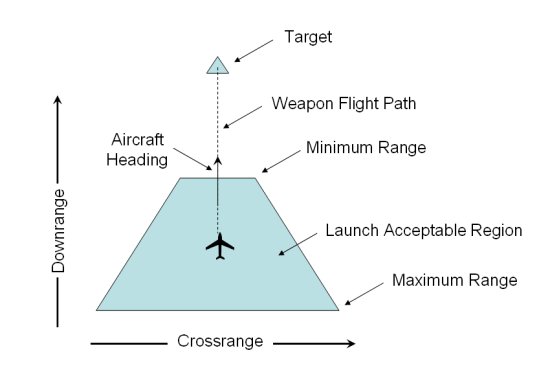
Note that the limits of the launch acceptability region are often defined by both minimum and maximum ranges. The maximum range is dictated by the kinematic and seeker performance issues we have already discussed. The minimum range is often a function of kinematic and seeker issues as well as structural limits, controllability, and safety concerns. For example, a weapon launched from an aircraft very close to the target may be forced to pitch over into a steep dive that causes it to accelerate to higher speeds than it was designed for. The higher velocity may result in aerodynamic forces larger than the weapon's structure is capable of withstanding or too high for the servos that adjust its control fins to overcome. Launching at too short a range might also provide too little time for the seeker data to be processed to generate the commands needed for successful navigation to the target. A minimum range requirement also gives the pilot time to fly a safe distance away from the target before the warhead detonates, thereby avoiding the danger of inadvertently damaging his or her own aircraft.
Also note that the above example illustrates a launch aircraft that is flying directly towards the target. This situation maximizes the weapon's forward kinematic energy resulting in a relatively large launch region. By comparison, this next example illustrates an aircraft flying at some heading angle that is offset from a direct line to the target.
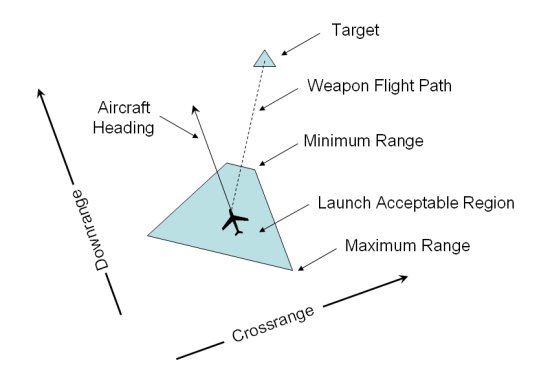
This type of scenario is often referred to as an off-axis or off-boresight launch. Such cases are made possible by the fact that many seekers have gimbals that allow the weapon to see a target that is not directly in front of it. If the gimbal limits are large enough, the weapon can potentially be aimed towards and locked onto a target that is at a considerable angle off of the aircraft's boresight. This capability gives a pilot the ability to launch towards targets off to his or her side and reduce the danger posed by enemy defenses. In such a case, however, part of the weapon's energy is used to turn it away from the flight path of the launch aircraft and move in a crossrange direction towards the target. This loss of energy reduces the overall performance of the weapon causing the launch region and maximum range to shrink.
The examples we have discussed so far assume the weapon has some sort of seeker that must be able to see the target before it is released from its parent aircraft. Other weapons, like those guided by the Global Positioning System (GPS), are not limited in this way. Since the weapon does not need to actually see the target, it does not necessarily need to be pointed towards the target at the time of launch. Instead of the wedge-shaped launch regions illustrated above, the LAR for a weapon of this kind usually looks more like a circle or ellipse surrounding the target of interest.
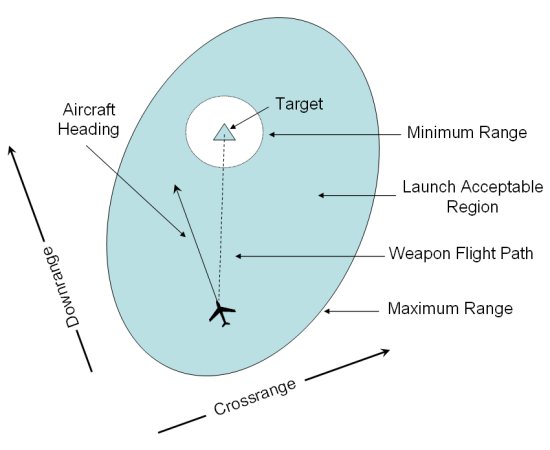
At the launch aircraft's given speed, altitude, and heading angle, the weapon could be released at any point within the shaded region to reach its target. The aircraft could even be flying directly away from the target and the weapon would still be able to reach it since it is not limited by any gimbal viewing angles to maintain a visual lock.
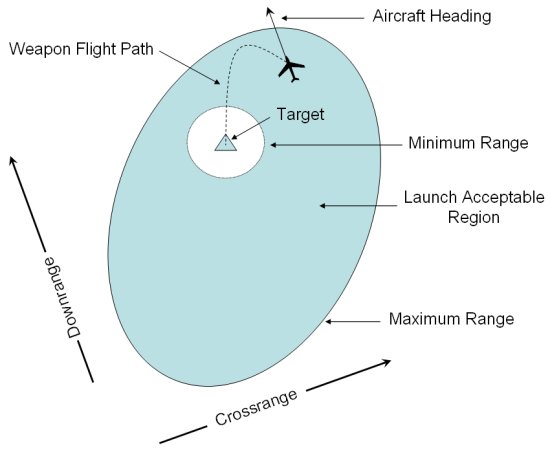
The above example illustrates such a case for a very high off-boresight scenario. In both this example and the previous one, the launch aircraft is flying at the same speed, altitude, and heading. Only its position relative to the target has changed. Since the aircraft is headed away from the target in this example, however, the weapon is forced to make a very large turn away from the aircraft's heading in order to move towards the target. This maneuver uses up much of the weapon's kinematic energy resulting in a much smaller maximum range in this region of the LAR compared to the previous example.
A further illustration of the importance of maneuvers in determining the size of the launch region can be seen below. This example assumes the weapon is capable of flying along a flight path that includes pre-programmed waypoints.
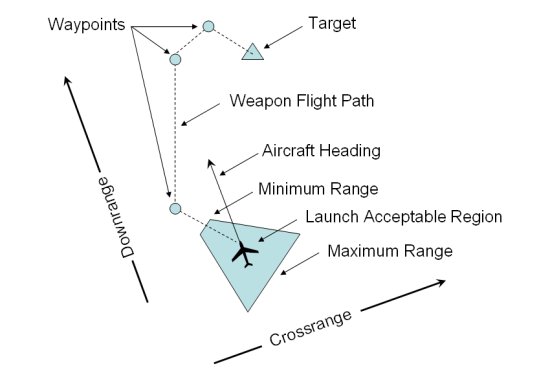
Many newer weapons have this capability to navigate to points in space along its flight path to the target in order to provide greater flexibility in how the weapon is employed. For example, it may be necessary to force the weapon to approach the target from a certain direction, command it to navigate around enemy defenses, or fly a particular route that avoids civilian populations. The ability to program these waypoints into the weapon prior to release provides a pilot with the flexibility to address concerns like these. However, forcing the weapon to make these numerous turns further reduces its kinematic energy and limits the overall size of the launch region. The more constraints that are added, the smaller the LAR will become for a given launch scenario.
While the concept of a launch acceptability region has been around for many years, it began to gain much more
significance following the introduction of guided weapons after World War II. These weapons gave pilots far more
capability in attacking both air and ground targets at great distances, but they needed instructions on how to best
employ those weapons to maximize their effectiveness. Early LAR charts were hard copies provided in manuals or on
kneeboards that pilots had to memorize or look up in flight. As miniaturized electronics became more prevalent,
engineers were able to provide computers in the aircraft to calculate LAR information and give the pilots a more
accurate assessment of when to launch a weapon. That trend continues today since many weapons are loaded with
sophisticated software that continuously calculates trajectory simulations and presents real-time, updated LAR
charts to pilots through their cockpit displays. Since computer processors continue to grow more powerful, the
speed and accuracy of these simulations will further improve and provide pilots with even more capability to
maximize the performance of the tools at their disposal.
- answer by Jeff Scott, 13 November 2005
Read More Articles:


|
Aircraft | Design | Ask Us | Shop | Search |

|
|
| About Us | Contact Us | Copyright © 1997-2023 | |||
|
|
|||